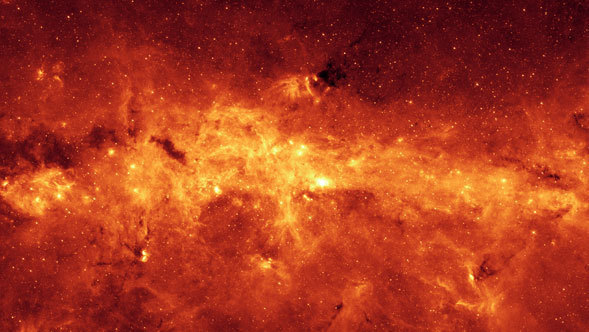
News Release • March 1st, 2006 • feature06-04 •
Written by Linda Vu
Spitzer Science Center
Five recent PhDs have just been offered the chance of a lifetime. They have been given three years to focus solely on their Spitzer-related research interests, access to Spitzer Science Center resources, and the option to work at a world-class US-based institution of their choice. Best of all, they'll be getting paid, thanks to the Spitzer Space Telescope Postdoctoral Fellowship program.
The new fellows were chosen from a pool of 85 applicants and represent some of the brightest young astronomers in the world. A selection committee of ten scientists met in January to recommend this year's new fellows.
"We had an incredibly competitive and impressive set of applications this year... the accepted fellows are some of the most talented recent astronomical PhDs out there," said Spitzer scientist Dr. Lisa Storrie-Lombardi.
According to Storrie-Lombardi, the Spitzer fellowship program is so competitive because it allows scientists to conduct independent research in their field of interest, with the only stipulation being that it enhances the overall scientific return of the Spitzer mission.
Thus, the astronomers can choose to conduct new observations with Spitzer, explore the mission's archives, or develop theories that will aid in the interpretation of Spitzer results.
"From Spitzer's end, we get a great return on our investment because the work that these fellows do will greatly benefit our overall mission," said Storrie-Lombardi. "Astronomers rarely get a chance to focus solely on their independent research and the fellowship program is yielding fantastic results."
The new fellows are:
- Dr. Kevin Covey who will receive a PhD from the University of Washington (2006). Covey will study The Spitzer Spectroscopic Star Formation Survey at the Harvard-Smithsonian Center for Astrophysics in Cambridge, Mass.
- Dr. Jonathan Fortney received a PhD from the University of Arizona (2004). Fortney will do his research on Giant Planets as a class of Astronomical Objects at NASA-ARC in Moffett Field, Calif.
- Dr. Emeric Le Floc'h received a PhD from the University of Paris (2003). Le Floc'h will be Probing The Dark Side of Cosmic Evolution Using Dark Gamma Ray Bursts at the University of Hawaii in Honolulu, Hawaii.
- Dr. Jane Rigby who will receive a PhD from the University of Arizona (2006). Rigby will be Finding and Understanding Highly Obscured Active Galactic Nuclei at Observatories of the Carnegie Institution of Washington in Pasadena, Calif.
- Dr. Brant Robertson who will receive a PhD from Harvard (2006). Robertson is researching Infrared Emission of Active Galactic Nuclei and Ultra-luminous Infrared Galaxies in Merger Simulations at the University of Chicago's Kavli Institute in Chicago, Ill.



